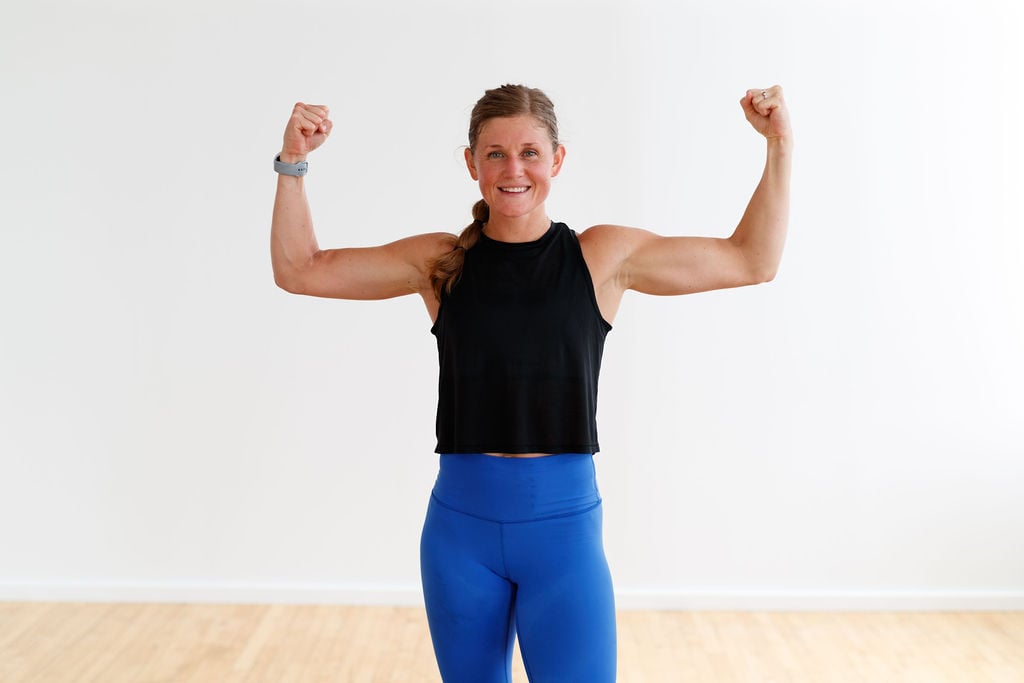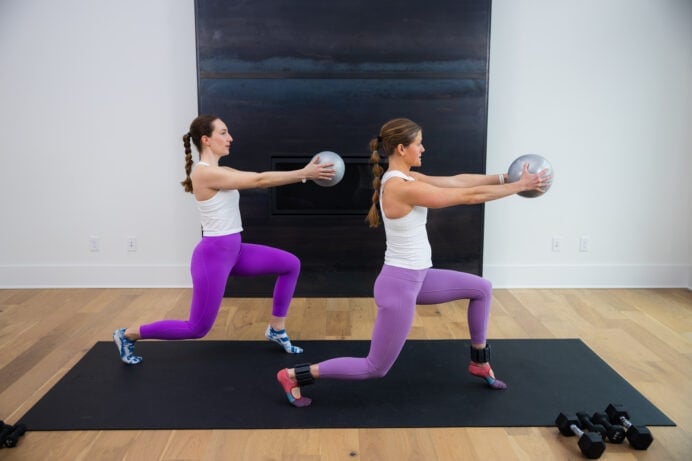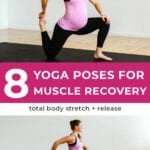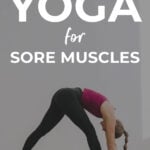

10-Minute Yoga: Active Recovery Yoga
Use this 10-minute active recovery yoga routine to recover from intense workouts (or to stretch out after sitting at a desk all day). Flow through these 8 yoga stretches to speed up recovery and relieve tight muscles.
Recovery has been a big priority for me, particularly as I continue to focus on lifting heavier during my strength training workouts.
For me, prioritizing recovery means incorporating active rest days, daily mobility and regular “deload” weeks.
Exercise and intense workouts put our muscles, connective tissues, joints and ligaments under stress and strain.
Muscle recovery needs to be a fundamental part of your fitness routine to keep you both injury-free and pain-free.

10 Minute Yoga Stretch: Yoga for Muscle Recovery
The perfect 10-minute active recovery workout at home. Stretch every muscle group in your body with an emphasis on the low back, hips and shoulders.
Include a 10 minute full body stretch in your home workout plan 1-2 times per week to protect and maintain healthy joints and muscles.
Workout Equipment:
No equipment, just your bodyweight and yoga mat.
Workout Instructions:
Follow along with the guided Active Recovery Yoga Routine on YouTube, led by personal trainer Lindsey Bomgren.
The Yoga Routine Looks Like This:
- 8 Active Recovery Yoga Stretches
- Hold Each Yoga Pose Around 60 Seconds. That said, you can make this yoga practice your own and hold poses longer if needed.

Prefer to Watch On YouTube?
Workout Outline
- Forward Fold and Thoracic Spine Rotations
- Downward Facing Dog
- Puppy Dog Stretch
- Low Lunge Hip Rocks
- Half Kneeling Quad Stretch
- Child’s Pose
- Legs Up the Wall Stretch (or Wide Leg Forward or Seated Fold)
- Reclined Squat or Wall Squat Pose (or Supported Yogi Squat)
8 Active Recovery Yoga Stretches
Forward Fold And Thoracic Spine Rotations
Benefits: Stretches your hips and hamstrings and releases tight lower back muscles. The forward fold stretch has also been known to stimulate your digestive system, calm your mind and soothe your nerves.
Do This Stretch If: If you have low back pain, or if you feel tight and sore after sitting at a desk for several hours. This stretch keeps your spine strong and flexible!

How To Do A Forward Fold And Thoracic Spine Rotation
- Start standing in Mountain Pose, feet hip-distance apart (or wider if needed), toes pointing straight ahead.
- As you inhale, reach your hands overhead.
- As you exhale, soften your knees and slowly fold forward from your hips. Pushing your hips back towards the wall behind you.
- Keep a soft bend in your knees as you reach your fingertips towards the mat.
- Keep your left hand on the mat and increase the bend in your left knee as you extend your right hand overhead. Gaze follows fingertips to the ceiling.
- Return your right hand to the mat and repeat this same thoracic spine rotation on the other side of the body.
Downward Facing Dog
Benefits: Strengthens and stretches the entire body – upper body, arms, shoulders, back, lower body, legs and feet. A great stretch for your posterior chain (backside of the body); increasing calf, ankle, hamstring and back mobility. Downward facing dog is a great way to stimulate blood circulation.
Do This Stretch If: You have a headache. Downward dog is known to decrease tension and headaches by elongating the cervical spine and neck and relaxing the head.
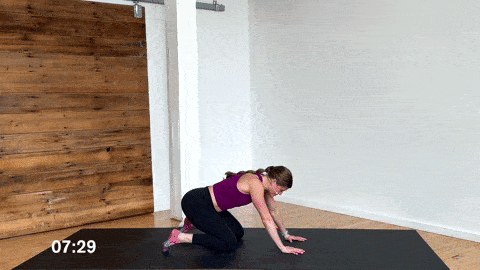
How To Do Downward Dog
- Start in a table top position (quadruped) on all fours; shoulders stacked over wrists and hips stacked over knees.
- Actively press your hands into the mat as you tuck your toes under.
- As you exhale, lift your knees off the mat, straightening your legs as you press your hips up towards the ceiling.
- Hold this position, pressing your chest towards your thighs.
Modification: If this inversion is uncomfortable, try quadruped (table top) hip circles. Or move onto puppy dog stretch, which is just a slight inversion with the heart just higher than the head.
Puppy Dog Stretch (Melting Heart Pose)
Benefits: Stretches neck, shoulders, spine and upper back.
Do This Stretch If: You need to release tension in your neck, shoulders and upper arms. I also really love doing this stretch before performing any overhead movements; a great way to increase range of motion for exercises like an overhead shoulder press.

How To Do Puppy Dog Stretch
- Start in a table top position (quadruped) on all fours; shoulders stacked over wrists and hips stacked over knees.
- Then walk your hands away from your body, extending your hands as far out in front of you as possible, while keeping your hips high.
- Hold this position, lengthening from fingertips to tailbone with each exhale.
Low Lunge Hip Rocks And Hip Opening Stretch
Benefits: Opens tight hips and stretches the quads and hamstrings.
Do This Stretch If: You have tight hips. A great stretch for runners.
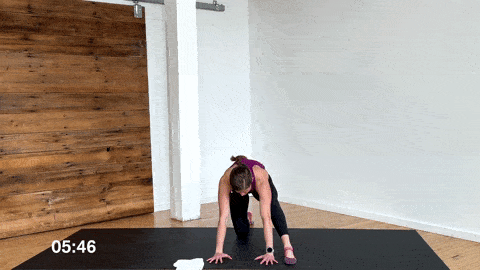
How To Do Low Lunge Hip Rocks And Hip Opening Stretch
- Start in a table top position (quadruped) on all fours; shoulders stacked over wrists and hips stacked over knees.
- Then step your right foot outside your right hand. Exhale as you drop your left hip towards the ground for a hip stretch.
- Hold this position or start to slowly shift your hips forward to increase the hip flexor stretch. Then slowly shift your hips back, straightening through your front right leg; stretching the hamstring of the front right leg.
- Repeat this movement shifting your hips back and forth to open the hips, quads and hamstrings.
Half Kneeling Quad Stretch (Hip Flexor Stretch)
Benefits: Stretches tight quadriceps, groins and hips. A great way to increase range of motion in the lower body.
Do This Stretch If: You have tight hip flexors and quads. Another great stretch for runners or anyone who sits a lot during the day.

How To Do A Half Kneeling Quad Stretch
- Start in a table top position (quadruped) on all fours; shoulders stacked over wrists and hips stacked over knees.
- Then step your right foot outside your right hand.
- Engage your core to release your hands from the mat and lift your upper body upright into a half kneeling position; kneeling on your back left knee (place a towel under your back knee for additional support). Shoulders stacked over hips, right front foot firmly on the mat and right thigh parallel to the ground.
- Hold this position as you tuck your tailbone under performing an anterior pelvic tilt to intensify the hip flexor, groin and quad stretch.
- Option to hold this position or intensify the quad stretch by pulling your back left heel towards your left butt cheek. If possible, reach your left hand back to grab your left foot. Hold this quad stretch.
Child’s Pose
Benefits: Stretches the hips, inner thighs, feet, spine and back. A great stretch to calm your body.
Do This Stretch If: You want to relieve lower back pain and stiff neck muscles.
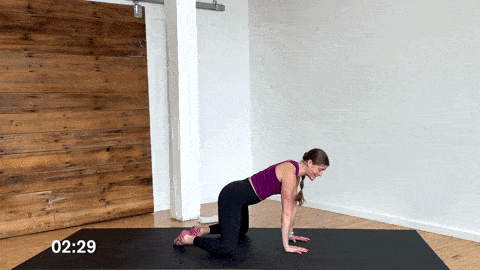
How To Do Child’s Pose
- Start in a table top position (quadruped) on all fours; shoulders stacked over wrists and hips stacked over knees.
- Keep your knees hip-width apart as you bring your big toes to touch.
- As you exhale, shift your hips back towards your heels and lower your torso between your knees.
- Then walk your hands away from your body. Extending your hands as far out in front of you as possible, shoulders relaxed.
- Hold this position, opening your hips and lengthening from fingertips to tailbone with each exhale.
Legs Up The Wall Stretch (Supported Vertical Leg Extension)
Benefits: Stretches the hamstrings, calves, low back and neck. A great stretch for improving circulation by reducing pressure in the legs and redirecting blood flow back towards your heart.
Do This Stretch If: You want to relieve tired legs and feet. A common stretch for endurance athletes like marathon runners. Also suggested as a ‘bedtime stretch’ as this stretch has been known to help you sleep.

How To Do Legs Up The Wall Stretch
- Start seated with bent knees and your right hip against the wall.
- Transition to lying flat on your back as you swing your legs up; squaring your hips off so both butt cheeks are as close to the wall as possible.
- Straighten your legs to a comfortable position, feet flexed, heels against the wall.
- Place your arms in a comfortable position at your sides and breathe deeply as you let the blood flow come back towards your heart.
Modification: Option to find a Wide Leg Forward Fold by standing tall with your feet wider than shoulder-width distance apart. Bend at the hips and place your hands flat on the floor, shoulder-width apart. You also have the option to find a Seated Fold by sitting on the ground, hinging at the hips and reaching your fingertips to your toes.
Reclined Squat (Wall Squat Pose)
Benefits: Stretches the lower back, hamstrings, hips and knees. A great stretch for relaxing the pelvic floor.
Do This Stretch If: You want to open tight hips and relax your pelvic floor. Also a great prenatal yoga pose to prepare for labor.
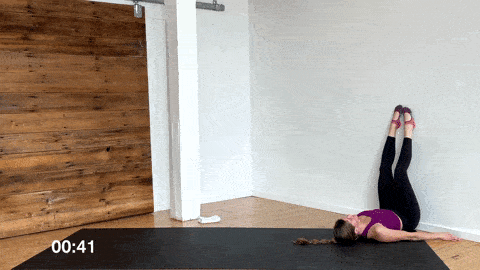
How To Do Reclined Wall Squat Or Wall Squat Pose
- Start seated with bent knees and your right hip against the wall.
- Transition to lying flat on your back as you swing your legs up; squaring your hips off so both butt cheeks are as close to the wall as possible.
- Place your feet on the wall, heels touching the wall. Slowly slide your heels down towards your hips and glutes, finding a wall squat pose.
- Place your arms in a comfortable position at your sides and breathe deeply as you let your hips open, relaxing your pelvic floor.
Modification: Option to find a Supported Yogi Squat by crouching down with your tailbone between your ankles, pressing your hands firmly together at your chest while pressing your elbows against your inner thighs.
Recovery Yoga FAQs
Active recovery is any kind of low impact movement that increases blood flow through your muscles. The goal is to push lactic acid (which causes muscle soreness) through your muscles after intense exercise. I recommend an active rest day (or an active recovery workout) at least 1-2 times a week.
Recovery yoga can help delayed onset muscle soreness (DOMS) or the reason you feel sore 24-to-48 hours after a tough workout. Yoga promotes blood flow, giving you the opportunity to focus on recovery and flexibility. Think of it as yoga for athletes to improve muscle recovery.
Yoga classes can increase joint mobility, improve cardiovascular fitness, prepare the body for the next day’s training, and relieve stress or anxiety.
More Workouts
StretchingPin this: 10-Minute Yoga for Active Recovery Days

This post includes affiliate links. I do make a small commission for products purchased using these links (at no additional cost to you). Thank you for supporting Nourish Move Love, making the content you see on this blog possible.










